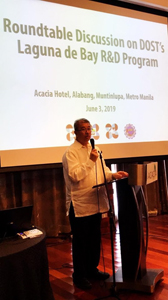 Results of the research and development program (R&D) on Laguna de Bay were discussed in a roundtable discussion (RTD) on June 3, 2019 at the Acacia Hotel, Alabang, Muntinlupa City.
Results of the research and development program (R&D) on Laguna de Bay were discussed in a roundtable discussion (RTD) on June 3, 2019 at the Acacia Hotel, Alabang, Muntinlupa City.
The Councils of the Department of Science and Technology (DOST-), Philippine Council for Agriculture, Aquatic and Natural Resources Research and Development (PCAARRD), Philippine Council for Industry, Energy and Emerging Technology Research and Development (PCIEERD), and National Research Council of the Philippines (NRCP) were joined by the Laguna Lake Development Authority (LLDA), National Academy of Science and Technology (NAST), University of the Philippines Los Baños (UPLB), and University of the Philippines Diliman (UPD) in the said RTD.
Led by its Acting Executive Director Dr. Reynaldo V. Ebora, the PCAARRD delegation included staff members from the Inland Aquatic Resources Research Division (IARRD), Socio-Economics Research Division (SERD), and Applied Communication Division (ACD).
According to Ebora, DOST has been involved in R&D on Laguna Lake since 1995 during the conduct of the “Integrated Action Program for the Rehabilitation of Laguna de Bay” monitored by the former Philippine Council for Aquatic and Marine Research and Development (PCAMRD). He also emphasized the economic importance of Laguna de Bay in providing 60% of freshwater fish supply to Metro Manila.
 DOST Secretary Fortunato T. de la Peña, in his address, confirmed that DOST’s R&D activities on Laguna Lake started during the launch of the Basin Approach to Environmentally Sound Management of Water Resources: Laguna de Bay (renamed later to Integrated Action Program for the Rehabilitation of Laguna de Bay) in 1995. Water quality and resource allocation enhancement were some of the outputs in that particular initiative. The Laguna Lake Development Authority (LLDA), the main beneficiary of the rehabilitation program, managed to allocate the lake’s water resources for sustainable development. In addition, issues and policy gaps identified towards enhanced lake management and its consequent development were also achieved after the completion of the R&D Program.
DOST Secretary Fortunato T. de la Peña, in his address, confirmed that DOST’s R&D activities on Laguna Lake started during the launch of the Basin Approach to Environmentally Sound Management of Water Resources: Laguna de Bay (renamed later to Integrated Action Program for the Rehabilitation of Laguna de Bay) in 1995. Water quality and resource allocation enhancement were some of the outputs in that particular initiative. The Laguna Lake Development Authority (LLDA), the main beneficiary of the rehabilitation program, managed to allocate the lake’s water resources for sustainable development. In addition, issues and policy gaps identified towards enhanced lake management and its consequent development were also achieved after the completion of the R&D Program.
The work of the Councils of DOST on Laguna Lake were discussed. The National Research Council of the Philippines of DOST (DOST-NRCP) came up with a policy brief based on the result of a study focusing on the detection of an emerging estrogenic pollutant. Meanwhile, the Philippine Council for Industry, Energy and Emerging Technology Research and Development (DOST-PCIEERD) funded the program, SCALE: Synergistic Capacity Advancement in the Management of Laguna Lake. Several researches were also conducted by the University of the Philippines Los Baños (UPLB) and UP Diliman (UPD).
De la Peña said that the greater challenge now is how to maximize and use the results of these researches to define actions that the DOST would take considering the lake’s present status, existing issues and concerns, aquaculture activities, infrastructure projects, existing ordinances and policies, and social projects for all the lake stakeholders.
 The RTD was divided into three sessions: 1) PCAARRD-funded Laguna de Bay Aquaculture Projects; 2) PCIEERD’s Water Quality Monitoring Projects implemented by the University of the Philippines Diliman; and 3) B3asic R&D researches funded by NRCP, which included Evaluation of Feral Fish Biomarkers for Monitoring of Estrogen Pollution in Laguna de Bay by Dr. Michelle Grace V. Paraso of UPLB.
The RTD was divided into three sessions: 1) PCAARRD-funded Laguna de Bay Aquaculture Projects; 2) PCIEERD’s Water Quality Monitoring Projects implemented by the University of the Philippines Diliman; and 3) B3asic R&D researches funded by NRCP, which included Evaluation of Feral Fish Biomarkers for Monitoring of Estrogen Pollution in Laguna de Bay by Dr. Michelle Grace V. Paraso of UPLB.
The activity was a convergence of efforts not only by DOST but also of other government agencies like the Department of Environment and Natural Resources (DENR), LLDA, and other local government units (LGUs). It aimed to update the status of Laguna de Bay, identify issues and concerns; enumerate the activities in the different parts of the lake (East, West and Central bays); determine the existing policies in each part of the lake; and identify plans/projects of DOST as a major player in the lake rehabilitation.
The activity was attended by a total of 38 participants from DOST, PCAARRD, PCIEERD, NRCP, LLDA, NAST, UPD, and UPLB.
